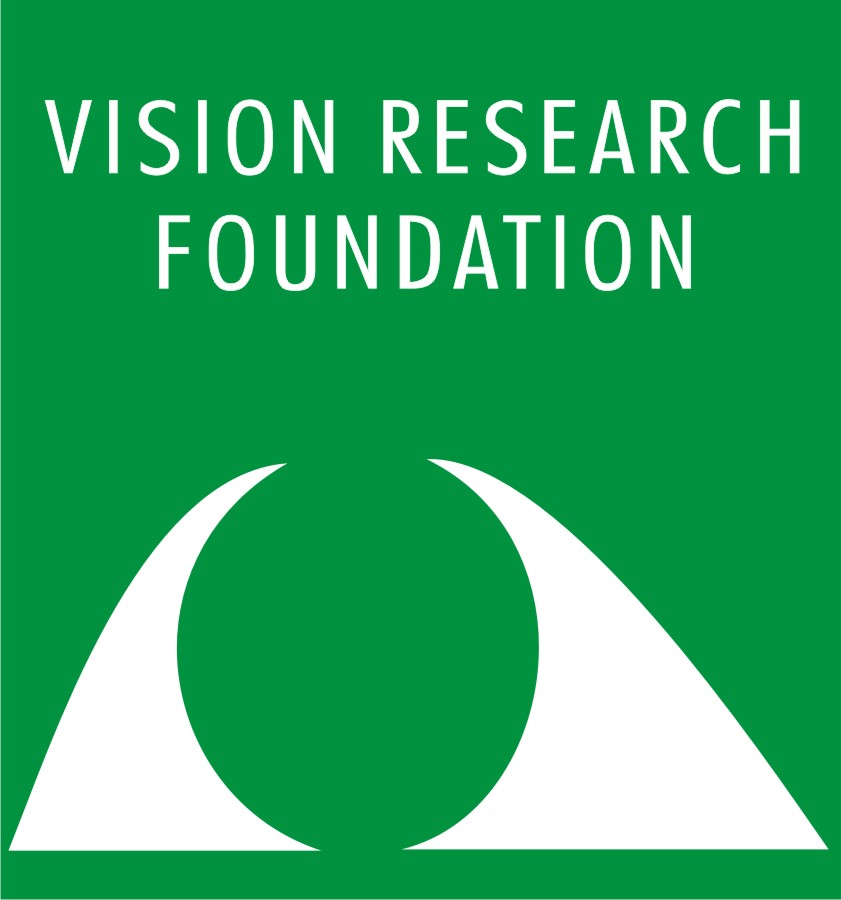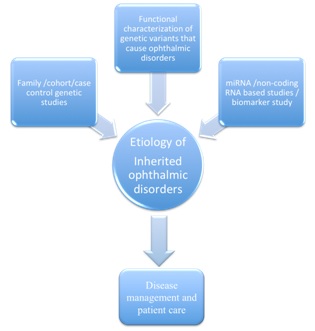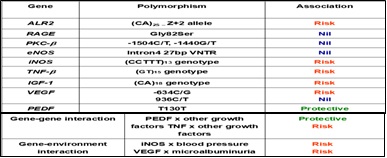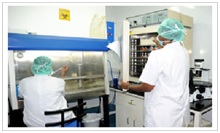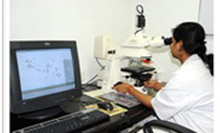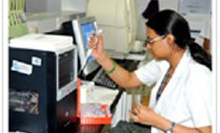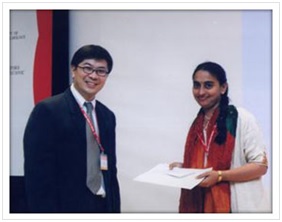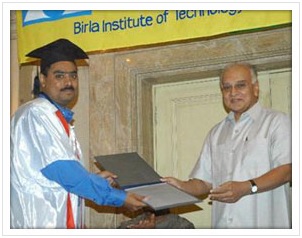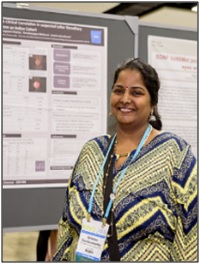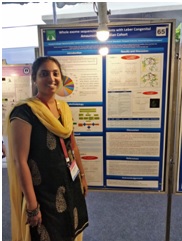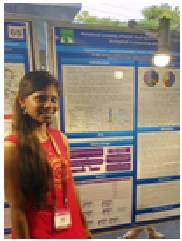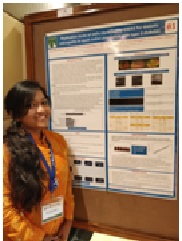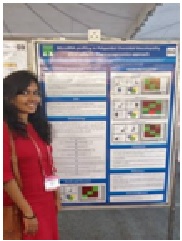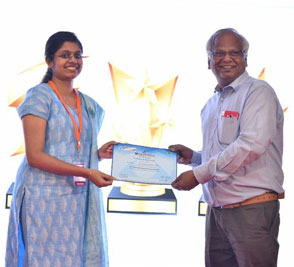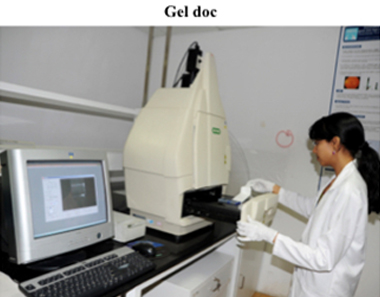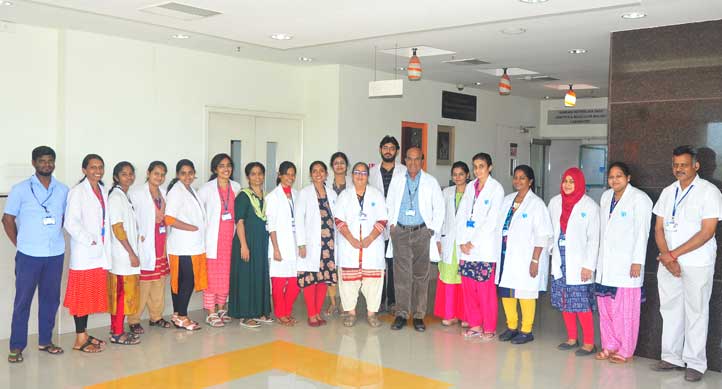
The department had its humble beginnings as a Cytogenetics laboratory in the year 1993.
Since then it has achieved rapid growth with the inclusion of a Molecular Biology set up,
and has evolved to the SN ONGC Department of Genetics and Molecular Biology. Our department
focus on research, diagnostic services like genetic tests, chromosomal study (karyotyping)
and genetic counseling for various ocular diseases. We have established a state of art
facility and infrastructure for advanced research in the field of ocular genetics and
genomics. Our areas of expertise include linkage analysis, association studies, genome wide
association studies [GWAS], mutational screening and molecular characterization. Similarly,
our department undertakes academic activities like Master’s and Ph.D programs affiliated
with SASTRA University, Tanjore, Alagappa University Karaikudi and SRM University,
Katankulathur, Chennai. . Competitive Hands-on summer training, observership programs and
short-term projects are being conducted every year for a designated number of students from
different educational institutions in India particularly in Tamilnadu. We have extensively
trained faculty members who dedicate themselves for teaching and research projects.
The faculty include Dr. Sinnakaruppan Mathavan (Senior Professor, Chief Scientist and HOD),
Dr. Sripriya (Associate Professor and Principal Scientist), Dr.S.Srilekha (Senior Scientist)
and Dr.N.N.Srikrupa (Senior Scientist). A total of 21 members are in the consisting of Ph.D.
students, research fellows, laboratory technicians, social worker and laboratory assistant.
The following the major research areas of the faculty in the department:
Dr.Mathavan’s research group is employing genomic techniques like, coding and non-coding RNA
sequencing (transcriptomics), whole exome sequencing, whole genome sequencing, genome-wide
association studies, genetic variations (SNPs) and disease association studies. They work on
selected ophthalmological diseases such as diabetic retinopathy (DR), age-related macular
degenerati0n (AMD), Polypoidal choroidal vasculopathy (PCV) Uveitis and Leber Congenital
Amaurosis (LCA). Dr.Sripriya is focusing on the genetic and molecular basis of inherited
ophthalmic diseases utilizing the recent technical advancements. Her research will lead to
clinical translation and committed services to patients & families with ocular genetic
disorders. Dr.Srilekha is interested in the area of optic neuropathy and inherited retinal
diseases. Also works on the mitochondrial genome following whole genome sequencing.
Dr.Srikrupa’s field of interest is on retinal diseases and to understand the genes/SNPs
associated with the disease. She is extensively using genomic tools such as Sanger
sequencing and whole exome sequencing.
Faculty
| Designation |
Name & E-Mail |
| In-charge
Senior Principal Scientist & Associate Professor
|
Dr.S.Sripriya, PhD
drss@snmail.org
|
| Senior Scientist(s) |
Dr. S. Srilekha, PhD
drsrilekha@snmail.org
Dr. N.N. Srikrupa, PhD
drsrikrupa@snmail.org
|
| PhD Students |
Ms. K. Suganya
Ms.A.L Lakshmi Priyankka
Ms.A.N.Rizza
Ms. Harshavardhini G
Ms. Aswathy P Nair
Ms. Syed Ali Fathima Afrin
Ms. Krishna Haridas
|
| Research Fellow (Project) |
Ms. Yuvashree R
Ms. Megha Thippanna
|
| Senior Project Technician |
Ms. Karthiyayini T |
| Lab Technicians |
Ms. P. Porkodi (Junior Executive) |
| Social Worker |
Dr. G. Venkatesan, PhD (Senior Executive) |
| Secretary |
Ms. N. Jeeva Jothi |
| Lab Attender |
Mr. N. Babu |
Ongoing projects
| S.No |
Project Investigator |
Title |
Funding Agency |
Duration |
| 1 |
Dr Mohana |
Mesenchymal stem cell mitochondrial transfer effectively protects mutant Leber’s
Hereditary Optic Neuropathy (LHON) cells from mitochondrial damage: Molecular
and epigenetic screening of LHON patients.
|
DST-SERB |
2021-2023 |
| 2 |
Dr Mohana |
Screening of mitochondrial transfer and epigenetic markers in Leber’s Hereditary
Optic Neuropathy (LHON) cells for its protective effect from mitochondrial
dysfunction.
|
ICMR |
2019-2022 |
| 3 |
Dr Mohana |
Analysis of protective effect of mesenchymal stem cell mitochondrial transfer on
mutant Leber’s hereditary Optic Neuropathy (LHON) cells from mitochondrial
damage.
|
CSIR |
2020-2023 |
| 4 |
Dr S Sripriya |
A study on the genetic regulatory regions of DIO3 gene for possible correlation
with varying clinical severity in LCA patients
|
ICMR |
2019-2022 |
| 5 |
Dr S Sripriya |
Profiling the promoter methylation status of candidate genes for ocular
quantitative traits in primary glaucoma patients
|
ICMR |
2019-2022 |
| 6 |
Dr S Sripriya |
In Search of the causative genetic/ molecular events in Bardet Biedl Syndrome
patients excluded for mutations in candidate genes
|
ICMR |
2020-2023 |
| 7 |
Dr S Sripriya |
A study on the DNA methylation pattern of the ocular quantitative trait loci/
genes in primary open angle glaucoma
|
ICMR |
2022-2024 |
| 8 |
Dr S Mathavan |
To identify circulating biomarkers for responders and non-responders to
anti-VEGF therapy in proliferative diabetic retinopathy (PDR), Medgenome Pvt
Ltd,
|
Medgenome Pvt Ltd |
2020-2022 |
| 9 |
Dr S Mathavan |
Artificial Intelligence for Affordable Screening and Prediction of Diabetic
Retinopathy in the Framework of Big Data (Jointly with Dr.Rajiv Raman), DBT,
|
DBT |
2022-2025 |
| 10 |
Dr S Mathavan |
Single nucleotide polymorphism (SNP) analysis in the diseases like Sarcoid
uveitis, Behcets disease and Vogt-Koyanagi harada syndrome. Jointly with
Dr.Jyotirmay Biswas, ICMR,
|
ICMR |
2022-2025 |
| 11 |
Dr S Mathavan |
PolypoidalChoroidalVasculopathy (PCV): microRNA and long non-coding RNA (LncRNA)
signature discovery as potential biomarkers in drug (anti-VEGF) responders and
non-responders (PI: Dr. S. Mathavan, Co-PI: Dr. S. Sririya)
|
Bayer |
2018-2023 |
Completed Projects
| S.No |
Title |
Funding Agency |
Duration |
| 1 |
Unraveling the genetic architecture of diabetic retinopathy in South India
(PI:Dr.S.Mathavan, Co-PI: Dr. S. Sririya)
|
DBT |
2018-2020 |
| 2 |
In silico Design and Development of novel peptide inhibitors targeting CD147
through virtual screening and biopanning of peptide libraries and in vitro
validation of anticancer efficacies.
|
ICMR |
2019-2021 |
| 3 |
A novel molecular screening approach for clinical and molecular characterization
of Usher syndrome patients in India (PI: Dr. S. Sripriya)
|
DBT |
2018-2021 |
| 4 |
IndoUS study of ocular quantitative traits predisposing to glaucoma (Co-PI: Dr.
S. Sripriya)
|
DBT |
2016-2019 |
| 5 |
Etiological profile of Pseudoexfoliation Syndrome in Indian population
accounting for genetic predisposition, ocular UV exposure and other
environmental factors (Co PI: Dr. S. Sripriya)
|
The Glaucoma Foundation |
2019 (one year) |
| 6 |
Intervention of ciliopathy genes in the molecular pathology of BBS in Indian
population
|
ICMR |
3 years |
| 7 |
Molecular genetic study of ocular developmental anomalies in south Indian
population (PI: Dr. S. Sripriya)
|
DST SERB Young scientist |
3 years |
| 8 |
A comprehensive analysis of microphthalmia and anophthalmia candidate genes in
Indian population (PI: Dr. S. Sripriya)
|
ICMR |
3 years |
| 9 |
Role of Lysyl oxidase and Homocysteine in plasma and aqueous humor of
Pseudoexfoliation patients (Co-PI: Dr. S. Sripriya)
|
ICMR |
3 years |
| 10 |
Screening of the ARMD patients for PON polymorphism and its functional
correlation at the level of the enzyme activity, oxidized LDL, and Homocysteine
(Co-PI: Dr. S. Sripriya)
|
DBT |
3 years |
| 11 |
Bardet- Biedl syndrome: molecular epidemiology and identification of novel genes
in the Indian cohort (PI: Dr. S. Sripriya)
|
ICMR INSERM collaborative initiative |
2 years |
| 12 |
Gene mapping for Myopia and identification of environmental risk factors for
myopia progression in subjects with genetic susceptibility (PI: Dr. S. Sripriya)
|
DST |
3 years |
| 13 |
India US Genetic Study of Ocular Quantitative Traits (Co-PI: Dr. S. Sripriya)
|
DBT |
2 years |
| 14 |
Genetic Association Studies & Fine Mapping Of Critical Genomic Regions That
Harbor Age Related Macular Degeneration (AMD) Susceptibility Loci/Genes/ Govt of
India (PI: Dr. S. Sripriya)
|
DBT |
3 years |
| 15 |
Mutation Characterization Of Genes Frequently Implicated In BBS Patients From
India (Co-PI: Dr. S. Sripriya)
|
ICMR-SRF Fellowship for Dr. SathyaPriya |
2 years |
| 16 |
Molecular genetics of Corneal Dystrophy – Mutational Screening of SLC4A11 and
COL8A2 gene in Fuchs Corneal Dystrophy (FCD) and Linkage analysis in FCD
affected Families / Indian Council of Medical Research, Govt of India (PI:Dr. N.
Soumittra)
|
ICMR |
3 years |
| 17 |
Gene expression profiling and development of micro array based biomarkers for
diabetic retinopathy - a pilot study. Functional genomic study of diabetic
retinopathy. (Co-PI:Dr. N. Soumittra)
|
DST |
2 years |
| 18 |
Molecular diagnostics of LCA- A chip based re-sequencing approach. (PI:Dr. N.
Soumittra)
|
DBT |
3 years |
| 19 |
Molecular Genetic profile of Congenital Stationary Night Blindness in India
using Arrayed Primer Extension (APEX) and Direct Sequencing to associate with
disease phenotype (PI:Dr. N. Soumittra)
|
ICMR |
2 years 6 months |
| 20 |
Fuch’s endothelial corneal Dystrophy (FCD) – Fine mapping and identifying
candidate gene for the novel loci 20p12.1- q13.2 in early onset family and study
the association of TCF4 gene in sporadic late onset FCD cases in our population
(PI:Dr. N. Soumittra)
|
ICMR |
3 years |
| 21 |
Characterization of consaguinousLeber congenital amaurosis families-
Homozygosity based approach (PI:Dr. N. Soumittra)
|
ICMR |
3 years |
| 22 |
Molecular and Historical analysis of neurological disorders associated with
mitochondrial DNA mutations. (Co-PI:Dr. N. Soumittra)
|
DBT |
3 years |
| 23 |
Confirmation of novel and reported mutations identified in LCA families by
Control Screening and to identify the causative gene/mutation in an autosomal
recessive Retinitis pigmentosa (arRP) family. (PI:Dr. N. Soumittra)
|
ICMR-SRF Fellowship for Dr.Srilekha |
2 years |
| 24 |
Peripheral Blood Gene Expression Profiling In Eales Disease (Co-PI:Dr. N.
Soumittra)
|
ICMR |
2 years |
| 25 |
Molecular Basis of X-Linked Juvenile Retinoschisis Mutational Screening of RS1
gene and functional characterization of the identified mutations. (PI: Dr. A. J.
Pandian)
|
DBT |
2 years |
| 26 |
Sankara Nethralaya Diabetic retinopathy epidemiology and molecular genetics
study III (SNDREAMS III): Rural arm/ /Jamshedji Tata Trust (PI: Dr. G.
Kumaramanikavel)
|
Jamshedji Tata Trust |
3 years |
| 27 |
Novel molecular diagnostics for eye diseases and low vision enhancement devices.
(PI: Dr. G. Kumaramanikavel)
|
CSIR_NMITLI |
3 years |
| 28 |
Epidemiological & Genetic Studies of Diabetic Retinopathy in Urban Chennai
(SNDREAMS I) (PI: Dr. G. Kumaramanikavel)
|
Jamshedji Tata Trust |
3 years |
| 29 |
Mutational screening of the Rhodopsin gene in patients of autosomal dominant
retinitis pigmentosa and RPE65 gene in patients of childhood onset autosomal
recessive retinitis pigmentosa and Lebers Congenital Amaurosis (PI: Dr. G.
Kumaramanikavel)
|
ICMR |
3 years |
| 30 |
Sankara Nethralaya Glaucoma Study & the Molecular Genetics of Glaucoma in the
South Indian Population. (PI: Dr. G. Kumaramanikavel)
|
Chennai-Willingdon |
3 years |
| 31 |
Developing DNA based diagnostic methods for Retinoblastoma and its phenotype
genotype correlation. (PI: Dr. G. Kumaramanikavel)
|
DBT |
3 years |
| 32 |
Sankara Nethralaya Diabetic retinopathy epidemiology and molecular genetics
study II (SNDREAMS II): Urban arm. (PI: Dr. G. Kumaramanikavel)
|
DBT |
3 years |
| 33 |
Gene Mapping Complex diseases: Adult Onset Cataract in India. (PI: Dr. G.
Kumaramanikavel)
|
DST |
3 years |
| 34 |
Retinal Cell profile in hereditary bilateral retinoblastoma (PI:Dr. G.
Kumaramanikavel)
|
VRF |
2 years |
Research Focus:
-
Establishing ocular Diagnostic Center
-
Execute research studies on genetic eye diseases of national importance, resulting in
blindness.
-
Understanding the molecular mechanisms of complex eye disorders like myopia, age related
macular degeneration, glaucoma, Fuchs’ endothelial corneal dystrophy and diabetic
retinopathy.
-
Establishing ocular disease DNA bank.
Research Highlights
Research on genetics of various eye diseases involves gene mapping employing high throughput
next generation sequencing based techniques involving traditional linkage analysis /
homozygosity mapping in families, targeted resequencing , whole exome sequencing approaches
for the identification of novel genes in inherited ophthalmic diseases.
GENETICS OF INHERITED RETINAL DYSTROPHIES
At the Genetic department, we have a well-organized pedigree database and DNA bank of
patients with various inherited ocular conditions. Gene mapping studies carried out on the
families identifed at our department, has led tot he discovery and involvement of genes
namely, rhodopsin, RPE65, prominin like 1, and arrestin for Retinitis pigmentosa families.
Lebers Congenital Amaurosis
Leber congenital amaurosis (LCA) and retinitis pigmentosa (RP) are the most severe and most
common inherited retinal degenerative (IRD) diseases, respectively. We have performed
homozygosity mapping on consanguineous autosomal recessive LCA, RP and cone-rod dystrophy
(CRD) families to identify the causative gene. Homozygosity mapping was performed using
Affymetrix human mapping array, 250K and 10K GeneChip. Twelve LCA and two arRP and one CRD
families were analysed by homozygosity mapping. Direct sequencing of shortlisted candidate
gene(s) identified the causative mutations in ten LCA and one arRP families. For one each of
LCA, arRP and CRD family, next generation based (NGS) targeted re-sequencing of 184 retinal
genes involved in IRD lead to identification of the causative mutation in all three.
Targeted re-sequencing was performed in the proband of these three families as the average
number of candidate genes within the homozygous blocks were five. In total mutations were
identified in eleven LCA, two arRP and one CRD families i.e. in 93% (14/15) of cases
studied. Mutations were identified in AIPL1 – 3 families, RPE65- 2 families, RDH12 -2
families and one each in GUCY2D, CRB1, IQCB1 and SPATA7 genes in the LCA and in MERTK and
ABCA4 genes in the arRP families and CDHR1 gene in CRD family and 64% of the mutations are
novel. The genotype-phenotype correlation was similar to earlier reports and specific to
certain genes as well. The results reveal the genetic heterogeneity of the disease and
suggest that these approaches are efficient tool for molecular testing in consanguineous
families.
Syndromic RP ( Bardet Beidl and Usher Syndrome)
As a part of Indo French collaboration initiative between ICMR and INSERM, the project was
conducted with Pr Hélène Dollfus from the Strasbourg university on understanding the
molecular epidemiology of BBS in the Indian cohort using a SNP based homozygosity mapping
method in 30 small consanguineous Indian pedigrees. The results were further validated in
another BBS cohort for recurrent mutations and rapid method of detection. This study has
contributed towards the understanding of genetic profile of BBS patients in Indian
population by identifying the mutations spectrum of BBS genes in Indian cohort with a
potential for diagnostic translation for the patients. Due to many novel genes appended for
BBS and the initial work did not include these regions, we are currently focusing on NGS
based targeted re sequencing panel based approach, spanning many ciliopathy genes including
the known BBS genes. A similar approach is also in progress for Usher syndrome in a sample
size of N=100.
Autosomal recessive congenital stationary night blindness
Congenital stationary night blindness (CSNB) is a clinically and genetically heterogeneous
retinal disorder which represents rod photoreceptor dysfunction or signal transmission
defect from photoreceptors to adjacent bipolar cells. Patients displaying photoreceptor
dysfunction show a Riggs-electroretinogram (ERG) while patients with a signal transmission
defect show a Schubert–Bornschein ERG. The Schubert–Bornschein is further subdivided into
complete or incomplete (ic) CSNB. Only few CSNB cases with Riggs-ERG and only one family
with a disease-causing variant in SLC24A1 have been reported. Whole-exome sequencing (WES)
in a previously diagnosed icCSNB patient identified a homozygous nonsense variant in
SLC24A1. Indeed, re-investigation of the clinical data corrected the diagnosis to Riggs-form
of CSNB. Targeted next-generation sequencing (NGS) identified compound heterozygous
deletions and a homozygous missense variant in SLC24A1 in two other patients, respectively.
ERG abnormalities varied in these three cases but all patients had normal visual acuity, no
myopia or nystagmus, unlike in Schubert–Bornschein type of CSNB. This confirms that SLC24A1
defects lead to Riggs type CSNB. In case of unclear clinical characteristics, NGS techniques
are helpful to clarify the diagnosis. This study is part of Indo-French collaboration funded
by ICMR-INSERM.
Genetic and Functional Characterization of mutations in X-linked Juinile
Retinoschisis
The study aimed at establishing a link between the phenotype and genotype based on the
molecular mechanism exerted by the mutations. Twenty seven XLRS patients were enrolled and
screened for mutations; seven harboured novel mutations. The mutant constructs were
genetically engineered and their secretion profiles were studied by in vitro cell culture
experiments. Based on the secretory profile, the patients were categorized as either
secreted or non-secreted group. Various clinical parameters such as visual acuity, location
of schisis, foveal thickness and ERG parameters were compared between the two groups and
control. Although the two groups showed severe disease phenotype in comparison with control,
there was no significant difference between the two XLRS groups. However, the secreted group
exhibited relatively severe disease indications. On the other hand molecular analysis
suggests that most of the RS1 mutations result in intracellular retention of retinoschisin.
Hence, clinical parameters of patients with non-secreted profile were analyzed which in turn
revealed wide variability even within the group. Altogether, our results indicate that
disease severity is not merely dependent on secretory profile of the mutations. Thus, we
hypothesize that intricate molecular detail such as the precise localization of mutant
protein in the cell as well as its ability to assemble into a functionally active oligomer
might largely influence disease severity among XLRS patients.
GENETICS OF OPHTHALMIC DISEASES WITH COMPLEX INHERITANCE
Primary Glaucomas ( open and angle closure glaucoma) and Pseudoexfoliation
syndrome
Research on molecular Genetics of glaucoma in Indian population was initiated at Sankara
Nethralya, as a part of a large epidemiology study titled “ The Chennai Glaucoma study”
(2002-2009) with the aim to understand the prevalence and molecular genetics of glaucoma in
south Indian population in a sample size of 4758 each for rural (32 contiguous villages
around Chennai) and the urban area comprising five random clusters in Chennai city in
eligible subjects aged ≥ 40 years. A detailed clinical examination, including glaucoma
diagnostic procedure was done at the examination center exclusively dedicated for the
project at Sankara Nethralaya. Pedigree ascertainment for genetic studies is performed for
subjects with glaucoma. Molecular genetics of both congenital and primary glaucomas (both
open angle and angle closure glaucoma) have been the focus of research at the department.
Candidate gene analysis for mutations in POAG have shown a frequency of 2-4% of mutations in
the population. Genome wide association studies by case control study design has implicated
the association of putative genetic loci for PACG and is the first genetic report on PACG
genes in the literature. Our Institution was part of the replication study for the ass
11q23.3, 6p21, 3p24 and 5q23 as discovered by deep re controls from nine countries.
Quantitative traits analysis in POAG and Myopia
As part of the Indo US grant, ( Prof Janey Wiggs, Massacuchets eye and ear infirmary) we
were able to collect large consanguineous families without any ocular pathology, from south
India to map the possible candidate ocular quantitative trait loci (QTLs) for glaucoma. The
project also demonstrated the power of consanguineous pedigrees over case control studies in
QTL mapping.
Genetic association of variations near/in genes like ATOH7, SIX1/SIX6 complex, CDKN2B,
CARD10, and CDC7 were analyzed in POAG and its QTs including vertical cup to disc ratio
(VCDR), central corneal thickness (CCT), intra ocular pressure (IOP), and axial length (AL)
by case control study in a sample size of 97 POAG cases and 371 controls from South India.A
potential interaction was identified for the first time in literature between SNPs near
ATOH7— CDC7, SIX6-CARD10, SIX6-CDC7 genes with POAG. SNPs near the genes (ATOH7, SIX6,
CDKN2B, CARD10, and CDC7) that did not show individual association with the disease however
correlated with increased risk when analyzed for interactions. We also replicated the
association of these genes with QTs as observed in other populations. Interactions among
genes like ATOH7, SIX6, CDKN2B and CDC7 suggests a putative additive role of the
developmental and growth signalling pathways in POAG as hypothesized in many studies. In
another study, the association of developmental genes with myopia and its quantitative
traits like axial length (AL) refractive error and corneal curvature (CC) was studied.
Genotype and haplotype analysis indicated significant association of the haplotype (CTGCGG)
bearing the T allele of s36015759 in MFRP gene with decreased axial length values even after
multiple correction.
Age Related Macular Degeneration (AMD)
AMD is a highly heritable progressive neurodegenerative disease that leads to loss of
central vision through death of photoreceptors. We were a part of AMD gene consortium that
included>17,100 advanced AMD cases and >60,000 controls of European and Asian ancestry. The
study identified a 32-kb region downstream of Y402H (rs1061170) as risk haplotype for AMD
development. Seven new loci (p< 5×10−8) were identified near the
genesCOL8A1/FILIP1L,IER3/DDR1, SLC16A8, TGFBR1, RAD51B, ADAMTS9/MR548A2 and B3GALTL were
also associated with AMD.
Diabetic Retinopathy (DR)
Candidate gene association studies for diabetic retinopathy are being conducted at
the SNONGC department of Genetics and Molecular Biology for the past 15 years; a
major part representing the SN-DREAMS (an epidemiology project on understanding the
prevalence of DR in rural and urban parts of Tamil Nadu; executed in 3 phases
(2003-2010) as given in table below. Currently, we colloborate with Dr Sudha K
Iyengar ( DBT Indo US project to foster vision science) to map common and rare
susceptibility loci for DR in Indian population.
Table : List of candidate genes studies for the association with type 2
diabetic retinopathy in Indian population
Fuchs endothelial corneal dystrophy
Fuchs endothelial corneal dystrophy (FECD) is genetically heterogenous degenerative
disease of the corneal endothelium with 50% of the cases showing autosomal dominant
inheritance and the rest being sporadic. Predominantly a late-onset disease, few
early-onset families have also been reported. SLC4A11 is one of the candidate genes
for the late-onset FECD. COL8A2 is the candidate gene for the early-onset FECD.
Screening SLC4A11 in 45 sporadic late-onset, 4 sporadic early-onset and one
autosomal dominant early-onset family identified mutations in three sporadic
late-onset cases. These mutations, c.719G4C (p.W240S), c.1519G4A (p.V507I) and
c.1304C4T (p.T434I) are novel. Functional studies of these mutants in HEK293 cells
revealed defects either in cell surface expression or rate of osmotically driven
water flux. Mutation in SLC4A11 was observed in 11% of the cohort studied. No
mutations were identified in COL8A2, in either the late-onset cohort or the
early-onset family, suggesting genetic heterogeneity in this FECD family.
MOLECULAR GENETIC ANALYSIS IN DEVELOPMENTAL DISORDERS OF THE EYE
Conventional and array based (arffymetrix cytoscan HD array) cytogenetic methods,
exon deletion analysis for PAX6 and SOX2 gene by MLPA and targeted resequencing of
candidate genes in Illumina platform are being done for understanding the genetics
of ocular developmental anomalies in Indian population. Twenty four samples
(Microphthalmia (M)-5, Anophthalmia (A)-7,Coloboma-2, M&A-1, microphthalmia and
coloboma / other ocular features-9) were initially analyzed using conventional
Geimsa Trypsin Geimsa banding of which 4 samples revealed gross chromosomal
aberrations (deletions in 3q26.3-28, 11p13 (N=2) and 11q23 regions). Targeted re
sequencing of candidate genes showed mutations in CHX10, PAX6, FOXE3, ABCB6 andSHH
genes in 6samples. High throughput array based chromosomal analysis revealed
aberrations in 4 samples (17q21dup (n=2), 8p11del (n=2)). Overall, genetic
alterations in known candidate genes are seen in 50% of the study subjects. Whole
exome sequencing was performed in samples that were excluded for mutations in
candidate genes are currently being studied
RETINOBLASTOMA
Retinoblastoma (Rb) is the most common primary intraocular cancer of childhood and
one of the major causes of childhood cancer death (1%) blindness (5%). Genetic
analysis of Rb1 gene has proven effective in early diagnosis and management of the
disease.We have also earlier shown that comprehensive screening of retinoblastoma
gene (chromosomal/ mutational / methylation analysisand promoter region methylation
screening of RB1 gene) is cost effective in carrier detection and disease management
for the families with retinoblastoma.NGS-based approaches increase the sensitivity
of mutation detection in the RB1 gene, making it fast and cost-effective compared to
the conventional tests The study suggested that NGS-based approaches increase the
sensitivity of mutation detection in the RB1 gene, making it fast and cost-effective
compared to the conventional tests performed in a reflex-testing mode. RB1 gene
screening of an 8-month-old female child with bilateral retinoblastoma was
accomplished using next generation sequencing. Prenatal testing and carrier testing
in mother revealed carrier status of the mother, which was further proceeded for
clinical examination in the family members. Prenatal genetic testing of the
developing fetus showed positivity for the mutation. The child was monitored for
tumour development and treated successfully upon detecting the tumour.Expression
analysis of KIF14 and E2F3 mRNA was done and it was found that there is an
overexpression of mRNA in Rb tumors.
LEBERS HEREDITARY OPTIC NEUROPATHY
LHON is the most common primary mitochondrial DNA (mtDNA) disorder in the population
and it is characterized by preferential loss of retinal ganglion cells, which
results in optic nerve degeneration and bilateral severe loss of central vision. We
have observed that T14484C mutation and G11778A mutations in `9% and 71%
repsectively of the total 90 LHON patients. As a part of multicentric study from
India. As a part of the multicentric study, we have reported that the
m.11778G>A-related LHON in India coexists with multiple different mtDNA haplogroups.
At present we have a Roche Collaborative Research project (Dr Patrick Yu-Wai-Man,
NewCastle University) titled “Mitochondrial genome landscape analysis in an Indian
cohort of Lebers Hereditary Optic Neuropathy (LHON) patients negative to primary
mutation (G3460A, G11778A, and T14484C)” with the aim of the study whole
mitochondrial genome in patients negative for the primary mutations.
GENOMIC APPROACHES FOR INDENTIFYING THERAPEUTIC TARGETS IN COMPLEX EYE
DISEASES
Whole transcriptome sequencing using RNA-seq to identify the differentially
expressed transcripts and novel transcripts (mRNA and miRNA) between drug responders
and non-responders in age related diseases like age related macular degeneration and
diabetic retinopathy.
Patient Care:
Genetics department is involved in (i) Genetic counselling (ii) Research on Genetics
of Eye Diseases. The department provides comprehensive molecular diagnostic testing
for inherited ophthalmic diseases, like retinal degenerative diseases, corneal
dystrophies, rare ophthalmic diseases, retinoblastoma, systemic diseases with
ophthalmic involvement like Bardet Beidle syndrome, Usher syndrome, using high
throughput next generation sequencing (NGS) technology. These results have potential
application in carrier testing and prenatal diagnosis in the afflicted families. We
offer genetic counseling to patients with inherited ophthalmic diseases through
genetic analysis (Chromosomal and Molecular)
Tests offered
Chromosomal study:Chromosomal Study requires peripheral blood from which lymphocytes
are extracted and cultured. Chromosomes in the cultured lymphocytes are studied
either in interphase/ metaphase/ prometaphase stage. The metaphase chromosomes are
preferred for analyzing the numerical/structural chromosomal abnormalities.
-
Damir Baranasic , …. Sinnakarupan Mathavan, etal. Integrated annotation and analysis of
genomic features reveal new types of functional elements and large-scale epigenetic
phenomena in the developing zebrafish. Nature Genetics ( in press) 2022; Authors: Damir
Baranasic et al (consortium paper total 25 authors)
-
Susarla G , Rizza A , Li A a, Han S , Khan R , Chan W , Lains I , Apivatthakakul A ,
Brustoski K , Khetan V , Raman R , Igo RP Jr, Iyengar SK , Mathavan S , Sobrin L.
Younger age and albuminuria are associated with proliferative diabetic retinopathy and
diabetic macular edema in the South Indian GeNetics of DiAbeTic Retinopathy (SIGNATR)
Study. Current Eye Research (in press, 2022)
-
Srikrupa N Natarajan, Harshavardhini G, Suganya Kandeeban, Srilekha Sundaramurthy,
Sarangapani Sripriya. An overview on the genetics etiology, testing and therapeutic
options for Retinitis Pigmentosa (Springer Nature, 2022) (Book Chapter)
-
Rajiv Raman, Swathipriya N, and S. Sripriya , Gene Therapy in Diabetic Retinopathy
(Springer Nature, 2022) (Book Chapter)
-
Suganya Kandeeban, Kaustubh Kandale, Porkodi Periyasamy, Muna Bhende, Pramod Bhende,
Mathavan Sinnakaruppan, Sarangapani Sripriya. Genetic testing in familial cases of
retinal detachment from India (2022). Indian Journal of Ophthalmalogy.
-
Mohana Devi S, Abishek Kumar B, Mahalaxmi I, Balachandar V. Leber's hereditary optic
neuropathy: Current approaches and future perspectives on Mesenchymal stem cell-mediated
rescue. Mitochondrion. 2021;60:201-218. Doi: 10.1016/j.mito.2021.08.013
-
Sundaramurthy S, Selvakumar A, Dharani V, Soumittra N, Mani J, Thirumalai K, Periyasamy
P, Mathavan S, Sripriya S. Prevalence of primary mutations in Leber hereditary optic
neuropathy: A five-year report from a tertiary eye care center in India. Molecular
vision. 2021;27:718
-
Srikrupa N Natarajan, Sarangapani Sripriya, Pavithra Suriyanarayanan, Parveen Sen, Ravi
Gupta, and Sinnakaruppan Mathavan. Whole exome sequencing identifies two novel ALMS1
mutations in Indian patients with Leber congenital amaurosis. Human Genome Variations.
Human Genome Variation (2021). 8:12-18.
-
Mohana Devi, S., Aswathy P Nair, Mahalaxmi, I., Balachandar, V.,. Mitochondrial function
and epigenetic outlook in Leber's Hereditary Optic Neuropathy (LHON). Neurology
Perspectives. 2021:1(4); 220-232. Doi: 10.1016/j.neurop.2021.07.003
-
Mohana Devi S. et al. Does epigenetics have a role in age related macular degeneration
and diabetic retinopathy? Genes and Diseases. 2020 Jan
23. doi: 10.1016/j.gendis.2020.01.003.
-
Quang Tien Phan, Wen Hui Tan, Ranran Liu, Sudha Sundaram, Anita Buettner, Susanne
Kneitz, Benedict Cheong, Himanshu Vyas, Sinnakaruppan Mathavan, Manfred Schartl and
Christoph Winkler. Cxcl9l-Cxcr3.2 chemokine signaling recruits osteoclast progenitors to
bone matrix in a medaka osteoporosis model. PNAS, (2020). 117: 19276–19286.
-
Alagappan, Lakshmi Priyankka, Joel En Wei Koh, V. Jahmunah, Adhithi Ramesh, Muna Bhende,
Rajiv Raman, U. Rajendra Acharya, and Sinnakaruppan Mathavan. "Development of an
automated system for the detection of genotype in polypoidal choroidal vasculopathy
using retinal image phenotype." Computer Methods and Programs in Biomedicine 192 (2020):
105460.
-
Mohana Devi Subramaniam, Mahalaxmi Iyer, Aswathy P. Nair, Dhivya Venkatesan,
Sinnakaruppan Mathavan, Nimmisha Eruppakotte, Soumya Kizhakkillach, Manoj kumar
Chandran, Ayan Roy, Abilash Valsala Gopalakrishnan, Balachandar Vellingiri. Oxidative
stress and mitochondrial transfer: A new dimension towards ocular diseases (2020). Genes
& Diseases. doi.org/10.1016/j.gendis.2020.11.020.
-
Parveen Sen, Puja Maitra, Srikrupa Natarajan, Srivatsan Sripriya , Sinnakaruppan
Mathavan , Muna Bhende & Pradeep T Manchegowda. CERKL mutation causing retinitis
pigmentosa (RP) in Indian population – a genotype and phenotype correlation study
(2020). Ophthalmic Genetics. 6: 570-578. DOI: 10.1080/13816810.2020.1814347
-
Sripriya S., Sharmila F., Kandeepan S., George R. Quantitative Trait for Glaucoma. In:
Prakash G., Iwata T. (eds) Advances in Vision Research, Volume II. Essentials in
Ophthalmology (2019). Springer, Singapore.
-
Locus.Fan BJ, Chen X, Sondhi N, Sharmila PF, Soumittra N, Sripriya S, Sacikala S, Asokan
R, Friedman DS, Pasquale LR, Gao XR, Vijaya L, Cooke Bailey J, Vitart V, MacGregor S,
Hammond CJ, Khor CC, Haines JL, George R, Wiggs JL, Family-Based Genome-Wide Association
Study of South Indian Pedigrees Supports WNT7B as a Central Corneal Thickness Mexican
American Glaucoma Genetic Study; International Glaucoma Genetics Consortium; and
NEIGHBORHOOD Consortium.Invest Ophthalmol Vis Sci. 2018 May 1;59(6):2495-2502.
-
Rao BS, Ansar S, Arokiasamy T, Sudhir RR, Umashankar V, Rajagopal R, Soumittra
N.,Analysis of candidate genes ZEB1 and LOXHD1 in late-onset Fuchs' endothelial corneal
dystrophy in an Indian cohort.Ophthalmic Genet. 2018 Aug;39(4):443-449.
-
Khan NA, Govindaraj P, Soumittra N, Sharma S, Srilekha S, Ambika S, Vanniarajan A, Meena
AK, Uppin MS, Sundaram C, Bindu PS, Gayathri N, Taly AB,Thangaraj K., Penetrance of the
LHON Mutation m.11778G>A May Depend on Factors Other Than Haplotype or Heteroplasmy
Rate.Invest Ophthalmol Vis Sci. 2018 Jan 1;59(1):382.
-
Srikrupa NN, Srilekha S, Sen P, Arokiasamy T, Meenakshi S, Bhende M, Kapur S, Soumittra
N., Genetic profile and mutation spectrum of Leber congenital amaurosis in a larger
Indian cohort using high throughput targeted re-sequencing.Clin Genet. 2018
Feb;93(2):329-339.
-
Rao BS, Tharigopala A, Rachapalli SR, Rajagopal R, Soumittra N., Association of
polymorphisms in the intron of TCF4 gene to late-onset Fuchs endothelial corneal
dystrophy: An Indian cohort study.Indian J Ophthalmol. 2017 Oct;65(10):931-935.
-
Khan NA, Govindaraj P, Soumittra N, Sharma S, Srilekha S, Ambika S, Vanniarajan A, Meena
AK, Uppin MS, Sundaram C, Bindu PS, Gayathri N, Taly AB, Thangaraj K., Leber's
Hereditary Optic Neuropathy-Specific Mutation m.11778G>A Exists on Diverse Mitochondrial
Haplogroups in India.Invest Ophthalmol Vis Sci. 2017 Aug 1;58(10):3923-3930.
-
Aung T, Ozaki M, Lee MC, Schlötzer-rehardt U, Thorleifsson G, Mizoguchi T, Igo RP Jr,
Haripriya A, Williams SE, Saravanan V, Venkatesh R, Shivkumar C, Kalpana N, Sarangapani
S, et al.,Genetic association study of exfoliation syndrome identifies a protective rare
variant at LOXL1 and five new susceptibility loci. Nat Genet. 2017 Jul;49(7):993-1004.
-
Nahid Akhtar Khan, Periyasamy Govindaraj, Nagasamy Soumittra, Sonika Sharma,
Sundaramoorthy Srilekha, Selvakumar Ambika, Ayyasamy Vanniarajan, Angamuthu, Kanikannan
Meena, Megha S. Uppin, Challa Sundaram, Parayil Sankaran Bindu, Narayanappa Gayathri,
Arun B. Taly, Kumarasamy Thangaraj. Leber’s Hereditary Optic Neuropathy – Specific
Mutationm.11778G>A Exists on Diverse Mitochondrial Haplogroups in India. Invest
Ophthalmol Vis Sci. 2017.
-
Sudha D, Kohansal-Nodehi M, Kovuri P, Manda SS, Neriyanuri S, Gopal L, Bhende P,
Chidambaram S, Arunachalam JP. Proteomic profiling of human intraschisis cavity fluid.
Clinical Proteomics. 2017 Apr 24;14(1):13. (International)
-
Neuillé M, Malaichamy S, Vadalà M, Michiels C, Condroyer C, Sachidanandam R, Srilekha S,
Arokiasamy T, Letexier M, Démontant V, Sahel JA, Sen P, Audo I, Soumittra N, Zeitz C.
Next-generation sequencing confirms the implication of SLC24A1 in autosomal-recessive
congenital stationary night blindness (CSNB). Clin Genet. 2016 Jan 29. Doi:
10.1111/cge.12746. [Epub ahead of print]
-
Priya S, Nampoothiri S, Sen P, Sripriya S. Bardet-Biedl syndrome: Genetics, molecular
pathophysiology, and disease management.Indian J Ophthalmol. 2016 Sep;64(9):620-627.
doi: 10.4103/0301-4738.194328. Review.(National )
-
Parag K. Shaha, S. Sripriyab, V. Narendrana, and A. J. Pandian. Prenatal genetic
diagnosis of retinoblastoma and report of RB1 gene mutation from India Ophthalmic
Genetics (2016) DOI: 10.3109/13816810.2015.1107595
-
Serum Paraoxonase activity in relation to lipid profile in Age-related Macular
Degeneration patients.AnandBabu K, Bharathidevi SR, Sripriya S, Sen P, Prakash VJ, Bindu
A, Viswanathan N, Angayarkanni N. Exp Eye Res. 2016 Sep 28;152:100-112[Epub ahead of
print]
-
Singh J, Mishra A, Pandian AJ, Mallipatna AC, Khetan V, Sripriya S, Kapoor S, Agarwal S,
Sankaran S, Katragadda S, Veeramachaneni V, Hariharan R, Subramanian K, Mannan AU. Next-generation
sequencing-based method shows increased mutation detection sensitivity in an Indian
retinoblastoma cohort. Mol Vis. 2016 Aug 16;22:1036-47.
-
Srilekha S, Rao B, Rao DM, Sudha D, Chandrasekar SP, Pandian AJ, Soumittra N, Sripriya
S. Strategies for Gene Mapping in Inherited Ophthalmic Diseases. Asia Pac J Ophthalmol
(Phila). 2016 Jul-Aug;5(4):282-92.
-
Gayathri R, Coral K, Sharmila F, Sripriya S, Sripriya K, Manish P, Shantha B, Ronnie G,
Vijaya L, Narayanasamy A. Correlation of Aqueous
Humor Lysyl Oxidase Activity with TGF-ß Levels and LOXL1 Genotype in
Pseudoexfoliation. Curr Eye Res. 2016 Oct;41(10):1331-1338.
-
Dhandayuthapani Sudha, Irene Rosita Pia Patric, Aparna Ganapathy, Smitha Agarwal, Shuba
Krishna, Srividya Neriyanuri, Sarangapani Sripriya, Praveen Sen, Subbulakshmi
Chidambaram and Jayamuruga PandianArunachalam. Genetic studies in a patient with
X-Linked Retinoschisis coexisting with Developmental Delay and Sensorineural Hearing
Loss. Ophthalmic Genetics (Just accepted). DOI: 10.1080/13816810.2016.1214972
-
Neriyanuri S, Dhandayuthapani S, Arunachalam JP, Raman R. Phenotypic characterization of
X-linked retinoschisis: Clinical, electroretinography, and optical coherence tomography
variables. Indian journal of ophthalmology. 2016 Jul;64(7):513. (International)
-
Sundaramurthy S, Swaminathan M, Sen P, Arokiasamy T, Deshpande S, John N, Gadkari RA,
Mannan AU, Soumittra N.Homozygosity mapping guided next generation sequencing to
identify the causative genetic variation in inherited retinal degenerative diseases. J
Hum Genet. 2016 Nov;61(11):951-958. 2016 Jul 7.
-
Sathya Priya C, Sen P, Umashankar V, Gupta N, KabraM, Kumaramanickavel G, Stoetzel C,
Dollfus H, Sripriya S., Mutation spectrum in BBS genes guided by homozygosity mapping in
an Indian cohort. Clin Genet. 2015 Feb;87(2):161-6.
-
Zheng Li, R Rand Allingham, Masakazu Nakano, Liyun Jia, Yuhong Chen, Yoko Ikeda,
Baskaran Mani, Li-Jia Chen, Changwon Kee, David F. Garway-Heath, Sarangapani Sripriya,
Nobuo Fuse, Khaled K. Abu-Amero, Chukai Huang, Prasanthi Namburi, Kathryn Burdon,
Shamira A Perera, Puya Gharahkhani, Ying Lin, Morio Ueno, Mineo Ozaki, Takanori
Mizoguchi, A common variant near TGFBR3 is associated with primary open angle glaucoma
SubbiahRamasamy Krishnadas. Hum Mol Genet. 2015 Apr 10.
-
Ferdinamarie Sharmila, Rashima Asokan, Vishwananthan N, Ronnie George, Lingam Vijaya,
Sarangapani Sripriya., Genetic association of SNPs near ATOH7, CARDIO, CDKN2B, CDX7 and
SIX1/SIX6 with the endophenotypes of primary open angle alaucoma in Indian population.
PLOS ONE, PLoS One. 2015 Mar 23
-
Srilekha S, Arokiasamy T, Srikrupa NN, Umashankar V, Meenakshi S, Sen P, Kapur S,
Soumittra N., Homozygosity Mapping in Leber Congenital Amaurosis and Autosomal Recessive
Retinitis Pigmentosa in South Indian Families. PLoS ONE 10(7): e0131679.
-
Nongpiur ME, Khor CC, Jia H, Cornes BK, Chen LJ, Qiao C, Nair KS, Cheng CY, Xu L, George
R, Tan D, Abu-Amero K, Perera SA, Soumittra N, Ramprasad VL, Waseem N, Yaakub A, Chia
KS, Kumaramanickavel G, Wong TT, How AC, Chau TN, Simmons CP, Bei JX, Zeng YX,
Bhattacharya SS, Zhang M, Tan DT, Teo. ABCC5, a Gene That Influences the Anterior
Chamber Depth, Is Associated with Primary Angle Closure Glaucoma. PLoS Genet. 2014 Mar
6;10(3):e1004089.
-
Soumittra N, Loganathan SK, Madhavan D, Ramprasad VL, Arokiasamy T, Sumathi S,
Karthiyayini T, Rachapalli SR,Kumaramanickavel G, Casey JR, Rajagopal R. Biosynthetic
and functional defects in newly identified SLC4A11 mutants and absence of COL8A2
mutations in Fuchs endothelial corneal dystrophy. J Hum Genet. 2014 Aug;59(8):444-53.
Epub 2014 Jul 10.
-
S Dhandayuthapani, S Sripriya, N Soumittra, Jayamuruga Pandian Arunachalam., Chapter 32,
Diagnostic Procedures for Genetically Transmitted Eye Diseases, in book - Diagnostic
Procedures in Ophthalmology (2014), Nema HV, Nema Nitin eds. Jaypee Brothers Medical
Publishers (P) Ltd, Pg 388-403.
-
Manish Pungliya, Minhas Sachin, Nagasamy Soumittra, Patil Shekar and Aggarwal Shyam. A
study of incidence of EGFR mutations in non-smoker adenocarcinoma of the lung: disparity
between North and South Indian patients. Journal of Cancer Therapeutics & Research 2014,
ISSN 2049-7962
-
Sharmila FM, Abinayapriya, Ramprabhu K Kumaramanickavel G, Sudhir RR, Sripriya S.,
Genetic analysis of axial length genes in high grade myopia from Indian population. Meta
Gene. 2014 Feb 15;2:164-75.
-
Christina Zeitz, PhD; Samuel G Jacobson,Christian P Hamel, Kinga Bujakowska, Marion
Neuillé, Elise Orhan, Xavier Zanlonghi, Marie-Elise Lancelot; Christelle Michiels;
Sharon B Schwartz, Béatrice Bocquet; CSNB consortium; Aline Antonio; Claire Audier;
Melanie Letexier, Jean-Paul Saraiva, Tien D Luu; Florian Sennlaub, Hoan Nguyen; Olivier
Poch, Hélène Dollfus, Odile Lecompte; Susanne Kohl, José-Alain Sahel, Shomi
Bhattacharya, Isabelle Audo. Whole exome sequencing identifies mutations in LRIT3 as a
cause for autosomal recessive complete stationary night blindness. Am J Hum Genet. 2013
Jan 10;92(1):67-75.
-
Bende P, Natarajan K, Marudhamuthu T, Madhavan J. Severity of familial isolated
retinitis pigmentosa across different inheritance patterns among an Asian Indian
cohort.J Pediatr Ophthalmol Strabismus. 2013 Jan-Feb;50 (1):34-6.
-
Fritsche LG, Chen W, Schu M, Yaspan BL, Yu Y, Thorleifsson G, Zack DJ, Arakawa S,
Cipriani V, Ripke S, Igo RP Jr, Iyengar SK, Yates JR, Swaroop A, Weber BH, Kubo M,
Deangelis MM, Léveillard T, Thorsteinsdottir U, Haines JL, Farrer LA, Heid IM, Abecasis
GR; AMD Gene Consortium. Seven new loci associated with age-related macular
degeneration. Nat Genet. 2013 Apr;45(4):433-9, 439e1-2. doi: 10.1038/ng.2578. Epub 2013
Mar 3.PMID:23455636[PubMed - indexed for MEDLINE]
-
Srikrupa NN, Meenakshi S, Arokiasamy T, Murali K, Soumittra N., Leber's Congenital
Amaurosis as the Retinal Degenerative Phenotype in Thiamine Responsive Megaloblastic
Anemia: A Case Report.Ophthalmic Genet. 2013 May [Epub ahead of print]
-
Khan NA, Govindaraj P, Soumittra N, Srilekha S, Ambika S, Vanniarajan A, Meena AK, Uppin
MS, Sundaram C, Taly AB, Bindu PS, Gayathri N, Thangaraj K. Haplogroup heterogeneity of
LHON patients carrying the m.14484T>C mutation in India. Invest Ophthalmol Vis Sci. 2013
Jun 10;54(6):3999-4005.
-
Sivasankar Malaichamy, Parveen Sen, Ramya Sachidanandam, Tharigopala Arokiasamy, Marie
Elise Lancelot, Isabelle Audo, Christina Zeitz, Nagasamy Soumittra., Molecular profiling
of complete congenital stationary night blindness: A pilot study on an Indian cohort.
Molecular Vison. 2014; 20: 341-351
-
Kumari Vinita, Sarangapani Sripriya, Krishnamurthy Prathiba, Kulothungan Vaitheeswaran,
Ravichandran Sathyabaarathi, Mahendran Rajesh, John Amali, Vetrivel Umashankar,
Govindasamy umaramanickavel, Swakshyar Saumya Pal, Rajiv Raman, Tarun Sharma, ICAM-1
K469E polymorphism is a genetic determinant for the clinical risk factors of T2D
subjects with retinopathy in Indians: a populationbased case–control study. SNDREAMS
project. BMJ Open. 2012 Aug 17;2(4).
-
Eranga N Vithana,Chiea-Chuen Khor, Chunyan Qiao, Monisha E Nongpiur Ronnie George,
Li-Jia Chen, Tan Do, Khaled Abu-Amero, Mani Baskaran, Balekudaru Shantha, Vedam L
Ramprasad, Govindasamy Kumaramanickave,Sudha K Iyengar. Genome-wide association analyses
identify three new susceptibility loci for primary angle closure glaucoma. Nat Genet.
2012 Oct;44(10):1142-6
-
Sivakumaran TA, Igo RP Jr, Kidd JM, Itsara A, Kopplin LJ, Chen W, Hagstrom SA, Peachey
NS, Francis PJ, Klein ML, Chew EY, Ramprasad VL, Tay WT, Mitchell P, Seielstad M,
Stambolian DE, Edwards AO, Lee KE, Leontiev DV, Jun G, Wang Y, Tian L, Qiu F, Henning
AK, LaFramboise T, Sen P, Aarthi M, George R, Raman R, Das MK, Vijaya L,
Kumaramanickavel G, Wong TY, Swaroop A, Abecasis GR, Klein R, Klein BE, Nickerson DA,
Eichler EE, Iyengar SK. A 32 kb critical region excluding Y402H in CFH mediates risk for
age-related macular degeneration. PLoS One. 2011; 6(10):e25598
-
Gandra Mamatha, Vetrivel Umashankar, Nachiappan Kasinathan, Tandava Krishnan,
Ravichandran Sathyabaarathi, Thirumalai Karthiyayini, John Amali, Chetan Rao, Jagadeesan
Madhavan. Molecular screening of the CYP4V2 gene in Bietti crystalline dystrophy that is
associated with choroidal neovascularization .Molecular Vision 2011; 17:1970-1977
-
Jagadeesan Madhavan1, Kandalam Mallikarjuna2, Khetan Vikas3, Ronnie George4,Rod
Bremner5, and Govindasamy Kumaramanickavel1. CDKN1C (p57KIP2) mRNA expression in human
retinoblastomas. Opthalmic genetics.2010.31 (3) : 141 – 146.
-
Uthra S, Raman R, Mukesh BN, Rajkumar SA, Kumari P, Lakshmipathy P, Gnanamoorthy P,
Sharma T, McCarty CA, Kumaramanickavel G. Diabetic retinopathy: Validation study of
ALR2, RAGE, iNOS and TNFB gene variants in a south Indian cohort. Ophthalmic Genet. 2010
Dec;31(4):244-51.
-
Uthra S, Raman R, Mukesh BN, Rajkumar SA, Kumari PR, Lakshmipathy P, Gnanamoorthy P,
Sharma T, McCarty CA, Kumaramanickavel G. Protein kinase C beta (PRKCB1) and pigment
epithelium derived factor (PEDF) gene polymorphisms and diabetic retinopathy in a south
Indian cohort. Ophthalmic Genet. 2010 Mar;31(1):18-23.
-
Tomas Aleman , Nagasamy Soumittra, Artur V. Cideciyan, Alexander Sumaroka,
VedamRamprasad, Waldo Herrera, Elizabeth A.M. Windsor, Sharon B Schwartz, Robert C
Russell, Alejandro J. Roman, Chris F. Inglehearn, Govindasamy Kumaramanickavel, Edwin M.
Stone, Gerald A. Fishman, and Samuel G. Jacobson. CERKL Mutations Cause an Autosomal
Recessive Cone-Rod Dystrophy With Inner Retinopathy. IOVS [in press]
-
MadhavanJ, Mitra M, MallikarjunaK,Pranav O, Srinivasan R, Nagpal A, Venkatesan P,
Kumaramanickavel G. KIF14 and E2F3 mRNA expression in human retinoblastoma and its
phenotype association. Molecular Vision 2009; 15:235-240.
-
Eranga N. Vithana, Patricio E. Morgan, VedamRamprasad, Donald T.H. Tan, Victor H.K Yong,
DivyaVenkataraman, AnandalakshmiVenkatraman, Gary H.F. Yam, Soumittra Nagasamy, Ricky
W.K. Law, Rama Rajagopal, Chi P. Pang, GovindsamyKumaramanickevel, Joseph R. Casey and
Tin Aung. SLC4A11 mutations in Fuchs endothelial corneal dystrophy. Hum. Mol. Genet; 17:
656-66.
-
Ali M, Ramprasad VL, Soumittra N, Mohamed MD, Jafri H, Rashid Y, Danciger M, McKibbin M,
Kumaramanickavel G, Inglehearn CF. A missense mutation in the nuclear localization
signal sequence of CERKL (p.R106S) causes autosomal recessive retinal degeneration. Mol
Vis. 2008;14:1960-4. Epub 2008 Oct 30.
-
Raman R, Rani PK, ReddiRachepalle S, Gnanamoorthy P, Uthra S, Kumaramanickavel G, Sharma
T. Prevalence of Diabetic Retinopathy in India Sankara Nethralaya Diabetic Retinopathy
Epidemiology and Molecular Genetics Study Report 2. Ophthalmology. 2008 Dec 11. [Epub
ahead of print]
-
Sen P, Bhargava A, George R, Ve Ramesh S, Hemamalini A, Prema R, Kumaramanickavel G,
Vijaya L. Prevalence of retinitis pigmentosa in South Indian population aged above 40
years. Ophthalmic Epidemiol. 2008 Jul-Aug;15(4):279-81.
-
Rani PK, Raman R, Subramani S, Perumal G, Kumaramanickavel G, Sharma T. Knowledge of
diabetes and diabetic retinopathy among rural populations in India, and the influence of
knowledge of diabetic retinopathy on attitude and practice. Rural Remote Health. 2008
Jul-Sep;8(3):838. Epub 2008 Jul 24.
-
Mamatha G, Srilekha S, Meenakshi S, KumaramanickavelGovindasamy. Screening of the RPE65
gene in the Asian Indian patients with leber congenital amaurosis. Ophthalmic Genet.
2008 Jun;29(2):73-8
-
Gandra M, Anandula V, Authiappan V, Sundaramurthy S, Raman R, Bhattacharya S,
Kumaramanickavel G. Retinitis pigmentosa: mutation analysis of RHO, PRPF31, RP1, and
IMPDH1 genes in patients from India. Mol Vis. 2008 Jun 14;14:1105-13.
-
Madhavan J, Ganesh A, Kumaramanickavel G. Retinoblastoma: from disease to discovery.
Ophthalmic Res. 2008;40(5):221-6. Epub 2008 Apr 29. Review.
-
Uthra S, Raman R, Mukesh BN, Rajkumar SA, Padmaja KR, Paul PG, Lakshmipathy P,
Gnanamoorthy P, Sharma T, McCarty CA, Kumaramanickavel G. Association of VEGF gene
polymorphisms with diabetic retinopathy in a south Indian cohort. Ophthalmic Genet. 2008
Mar;29(1):11-5.
-
Ramprasad VL, Soumittra N, Nancarrow D, Sen P, McKibbin M, Williams GA, Arokiasamy T,
Lakshmipathy P, Inglehearn CF, Kumaramanickavel G. Identification of a novel splice-site
mutation in the Lebercilin (LCA5) gene causing Leber congenital amaurosis. Mol Vis. 2008
Mar 10;14:481-6.
-
Ramprasad VL, George R, Soumittra N, Sharmila F, Vijaya L, Kumaramanickavel G.
Association of non-synonymous single nucleotide polymorphisms in the LOXL1 gene with
pseudoexfoliation syndrome in India. Mol Vis. 2008 Feb 9;14:318-22.
-
Prema R, George R, SathyamangalamVe R, Hemamalini A, Baskaran M, Kumaramanickavel G,
Catherine M, Vijaya L. Comparison of refractive errors and factors associated with
spectacle use in a rural and urban South Indian population. Indian J Ophthalmol. 2008
Mar-Apr;56(2):139-44.
-
Vithana EN, Morgan PE, Ramprasad V, Tan DT, Yong VH, Venkataraman D, Venkatraman A, Yam
GH, Nagasamy S, Law RW, Rajagopal R, Pang CP, Kumaramanickevel G, Casey JR, Aung T.
SLC4A11 mutations in Fuchs endothelial corneal dystrophy. Hum Mol Genet. 2008 Mar
1;17(5):656-66. Epub 2007 Nov 16.
-
Madhavan J, Ganesh A, Roy J, Biswas J, Kumaramanickavel G. The relationship between
tumor cell differentiation and age at diagnosis in retinoblastoma. J PediatrOphthalmol
Strabismus. 2008 Jan-Feb;45(1):22-5.
-
Uthra S, Raman R, Mukesh BN, Kumari RP, Sharma T, McCarty CA, Kumaramanickavel G.
Genetics of diabetic retinopathy. Int J Hum Genet 2008 8(1-2):155-9.
-
Madhavan J, Coral K, Mallikarjuna K, Corson TW, Amit N, Khetan V, George R, Biswas J,
Gallie BL, Kumaramanickavel G. High expression of KIF14 in retinoblastoma: association
with older age at diagnosis. Invest Ophthalmol Vis Sci. 2007 Nov;48(11):4901-6.
-
Rani PK, Raman R, Sharma V, Mahuli SV, Tarigopala A, Sudhir RR, Kumaramanickavel G,
Sharma T. Analysis of a comprehensive diabetic retinopathy screening model for rural and
urban diabetics in developing countries. Br J Ophthalmol. 2007 Nov;91(11):1425-9.
-
Vijaya L, George R, Arvind H, Baskaran M, Ve Ramesh S, Raju P, Kumaramanickavel G,
McCarty C. Prevalence of primary angle-closure disease in an urban south Indian
population and comparison with a rural population. The Chennai Glaucoma Study.
Ophthalmology. 2008 Apr;115(4):655-660.e1. Epub 2007 Sep 17.
-
Uthra S, Raman R, Mukesh BN, Rajkumar SA, Kumari R P, Agarwal S, Paul PG, Lakshmipathy
P, Gnanamoorthy P, Sharma T, McCarty CA, Kumaramanickavel G. Diabetic retinopathy and
IGF-1 gene polymorphic cytosine-adenine repeats in a Southern Indian cohort. Ophthalmic
Res. 2007;39(5):294-9. Epub 2007 Sep 12.
-
Vijaya L, George R, Baskaran M, Arvind H, Raju P, Ramesh SV, Kumaramanickavel G, McCarty
C. Prevalence of primary open-angle glaucoma in an urban south Indian population and
comparison with a rural population. The Chennai Glaucoma Study. Ophthalmology. 2008
Apr;115(4):648-654.e1. Epub 2007 Jul 30.
-
Sripriya S, George R, Arvind H, Baskaran M, Raju P, Ramesh SV, Karthiyayini T, Vijaya L,
Kumaramanickavel G. Transforming growth factor beta-1 -509C>T polymorphism in Indian
patients with primary open angle glaucoma. MolDiagnTher. 2007;11(3):151-4.
-
Uthra S, Raman R, Mukesh BN, PadmajaKumari R, Paul PG, Lakshmipathy P, Gnanamoorthy P,
Sharma T, McCarty CA, Kumaramanickavel G. Intron 4 VNTR of endothelial nitric oxide
synthase (eNOS) gene and diabetic retinopathy in type 2 patients in southern India.
Ophthalmic Genet. 2007 Jun;28(2):77-81.
-
Ramprasad VL, George RJ, Sripriya S, Nirmaladevi J, Vijaya L, Kumaramanickavel G.
Molecular genetic analysis of a consanguineous south Indian family with congenital
glaucoma: relevance of genetic testing and counseling. Ophthalmic Genet. 2007
Mar;28(1):17-24.
-
Ramprasad VL, Ebenezer ND, Aung T, Rajagopal R, Yong VH, Tuft SJ, Viswanathan D,
El-Ashry MF, Liskova P, Tan DT, Bhattacharya SS, Kumaramanickavel G, Vithana EN. Novel
SLC4A11 mutations in patients with recessive congenital hereditary endothelial dystrophy
(CHED2). Mutation in brief #958. Online. Hum Mutat. 2007 May;28(5):522-3.
-
Joseph B, Kumaramanickavel G. ‘Insight’ into molecular genetic testing in
retinoblastoma. Int J Hum Genet. 2007 Mar;7(1):23-8.
-
S Sripriya, R George, L Vijaya, G Kumaramanickavel (2007). Understanding the biology of
glaucoma : The current scenario. Journal of Current Glaucoma Practice. 1: 7-16
-
Joseph B, Raman R, Uthra S, Jagadeesan M, Ganesh A, Paul PG, Sharma T, Kumaramanickavel
G. Genotype-phenotype correlation analysis in retinoblastoma patients from India. Asian
Pac J Cancer Prev. 2006 Oct-Dec;7(4):619-22.
-
Balasubramanian D, Kaufman PL, Wiggs JL, Kumaramanickavel G, Mandal A, Maumenee I,
Nirmalan PK, Friedman D, Biswas J. Rao GN, Zack D. Research Opportunities in Vision: A
Report of the US-Indo Workshops on Collaborative Research. Investigative ophthalmology
and Visual Science 2006; 47:1717-1735.
-
Joseph B, Madhavan J, Mamatha G, Ramprasad VL, Gopal L, Kumaramanickavel G.
Retinoblastoma: a diagnostic model for India. Asian Pac J Cancer Prev. 2006
Jul-Sep;7(3):485-8.
-
Agarwal S, Raman R, Kumari RP, Deshmukh H, Paul PG, Gnanamoorthy P, Kumaramanickavel G,
Sharma T. Diabetic retinopathy in type II diabetics detected by targeted screening
versus newly diagnosed in general practice. Ann Acad Med Singapore. 2006
Aug;35(8):531-5.
-
Sripriya S, Nirmaladevi J, George R, Hemamalini A, Baskaran M, Prema R, Ve Ramesh S,
Karthiyayini T, Amali J, Job S, Vijaya L, Kumaramanickavel G. OPTN gene: profile of
patients with glaucoma from India. Mol Vis. 2006 Jul 24;12:816-20.
-
Vijaya L, George R, Arvind H, Baskaran M, Raju P, Ramesh SV, Paul PG, Kumaramanickavel
G, McCarty C. Prevalence and causes of blindness in the rural population of the Chennai
Glaucoma Study. Br J Ophthalmol. 2006 Apr;90(4):407-10.
-
Vijaya L, George R, Arvind H, Baskaran M, Paul PG, Ramesh SV, Raju P, Kumaramanickavel
G, McCarty C. Prevalence of angle-closure disease in a rural southern Indian population.
Arch Ophthalmol. 2006 Mar;124(3):403-9.
-
Joseph B, Paul PG, Elamparithi A, Roy J, Vidhya A, Shanmugam MP, Kumaramanickavel G.
Karyotyping in retinoblastoma--a statistical approach. Asian Pac J Cancer Prev. 2005
Oct-Dec;6(4):468-71
-
Vijaya L, George R, Paul PG, Baskaran M, Arvind H, Raju P, Ramesh SV, Kumaramanickavel
G, McCarty C. Prevalence of open-angle glaucoma in a rural south Indian population.
Invest Ophthalmol Vis Sci. 2005 Dec;46(12):4461-7
-
Ramprasad VL, Sripriya S, Ronnie G, Nancarrow D, Saxena S, Hemamalini A, Kumar D, Vijaya
L, Kumaramanickavel G. Genetic homogeneity for inherited congenital microcoria loci in
an Asian Indian pedigree. Mol Vis. 2005 Nov 3;11:934-40
-
Agarwal S, Mahajan S, Rani PK, Raman R, Paul PG, Kumaramanickavel G, Sharma T. How high
is the non-response rate of patients referred for eye examination from diabetic
screening camps? Ophthalmic Epidemiol. 2005 Dec;12(6):393-4.
-
Rani PK, Raman R, Agarwal S, Paul PG, Uthra S, Margabandhu G, Senthilkumar D,
Kumaramanickavel G, Sharma T. Diabetic retinopathy screening model for rural population:
awareness and screening methodology. Rural Remote Health. 2005 Oct-Dec;5(4):350. Epub
2005 Oct 10.
-
Paul PP, George RJ, Arvind H, Raj M, Augustian, Ramesh SV, Sriram P, Kumaramanickavel G,
McCarthy C, Vijaya L. A comparison of participants and non-participants in the Chennai
Glaucoma Study-rural population. Ophthalmic Epidemiol. 2005 Apr;12(2):125-35.
-
Agarwal S, Raman R, Paul PG, Rani PK, Uthra S, Gayathree R, McCarty C, Kumaramanickavel
G, Sharma T. Sankara Nethralaya-Diabetic Retinopathy Epidemiology and Molecular Genetic
Study (SN-DREAMS 1): study design and research methodology. Ophthalmic Epidemiol. 2005
Apr;12(2):143-53.
-
Joseph B, Shanmugam MP, Srinivasan MK, Kumaramanickavel G. Retinoblastoma: genetic
testing versus conventional clinical screening in India. MolDiagn. 2004;8(4):237-43.
-
Madhavan C, Bhende P, Gopal L, Vasanthi SB, Kumaramanickavel G. Retinitis pigmentosa
patients with sickle cell disease and dextrocardia and situsinversus syndrome. Indian J
Ophthalmol. 2001 Sep;49(3):193-5
-
Harini R, Ata-ur-Rasheed M, Shanmugam MP, Amali J, Das D, Kumaramanickavel G. Genetic
profile of 81 retinoblastoma patients from a referral hospital in southern India. Indian
J Ophthalmol. 2001 Mar;49(1):37-42.
-
Ramprasad VL, Thool A, Murugan S, Nancarrow D, Vyas P, Rao SK, Vidhya A, Ravishankar K,
Kumaramanickavel G. Truncating mutation in the NHS gene: phenotypic heterogeneity of
Nance-Horan syndrome in an asian Indian family. Invest Ophthalmol Vis Sci. 2005
Jan;46(1):17-23.
-
Joseph B, Narayana KS, Mamatha G et al. Mutational Screening of RB1 gene by multiplex
PCR. Ind J Biotech. 2005 Apr;4(2):194-200.
-
Raju P, Ramesh SV, Arvind H, George R, Baskaran M, Paul PG, Kumaramanickavel G, McCarty
C, Vijaya L. Prevalence of refractive errors in a rural South Indian population. Invest
Ophthalmol Vis Sci. 2004 Dec;45(12):4268-72.
-
Sripriya S, Uthra S, Sangeetha R, George RJ, Hemamalini A, Paul PG, Amali J, Vijaya L,
Kumaramanickavel G. Low frequency of myocilin mutations in Indian primary open-angle
glaucoma patients. Clin Genet. 2004 Apr;65(4):333-7
-
Kumaramanickavel G (2004). Genetic Diseases of the Eye in India. Genetic Disorders of
the Indian Subcontinent. (Ed Dhavendra Kumar) pp 369-398, Springer, 2004. ISBN
1402012152, 9781402012150.
-
Kumaramanickavel G, Joseph B, Vidhya A, Arokiasamy T, Shridhara Shetty N. Consanguinity
and ocular genetic diseases in South India: analysis of a five-year study. Community
Genet. 2002;5(3):182-5.
-
Joseph B, Mamatha G, Raman G, Shanmugam MP, Kumaramanickavel G. Methylation status of
RB1 promoter in Indian retinoblastoma patients. Cancer BiolTher. 2004 Feb;3(2):184-7.
Epub 2004 Feb 1.
-
Kumaramanickavel G, Joseph B, Narayana K, Natesh S, Mamatha G, Shanmugam MP, Elamparathi
A, Biswas J. Molecular-genetic analysis of two cases with retinoblastoma: benefits for
disease management. J Genet. 2003 Apr-Aug;82(1-2):39-44.
-
Arvind H, Paul PG, Raju P, Baskaran M, George R, Balu S, Sripriya S, Ramesh SV, Mukesh
BN, Vijaya L, Kumaramanickavel G, McCarty C. Methods and design of the Chennai Glaucoma
Study. Ophthalmic Epidemiol. 2003 Dec;10(5):337-48.
-
Kumaramanickavel G, Sripriya S, Ramprasad VL, Upadyay NK, Paul PG, Sharma T. Z-2 aldose
reductase allele and diabetic retinopathy in India. Ophthalmic Genet. 2003
Mar;24(1):41-8.
-
Ramprasad VL, Rao SK, Ravishankar K, Kumaramanickavel G. Genetic studies in age related
cataract: Problems encountered. Invest Ophthalmol Vis Sci. (9 Oct 2003) E letters to the
editor.
-
Kumaramanickavel G, Ramprasad VL, Sripriya S, Upadyay NK, Paul PG, Sharma T. Association
of Gly82Ser polymorphism in the RAGE gene with diabetic retinopathy in type II diabetic
Asian Indian patients. J Diabetes Complications. 2002 Nov-Dec;16(6):391-4.
-
Joseph B, Srinivasan A, Soumittra N, Vidhya A, Shetty NS, Uthra S, Kumaramanickavel G.
RPE65 gene: multiplex PCR and mutation screening in patients from India with retinal
degenerative diseases. J Genet. 2002 Apr;81(1):19-23.
-
Kumaramanickavel G, Sripriya S, Vellanki RN, Upadyay NK, Badrinath SS, Rajendran V,
Sukumar B, Ramprasad VL, Sharma T. Inducible nitric oxide synthase gene and diabetic
retinopathy in Asian Indian patients. Clin Genet. 2002 May;61(5):344-8.
-
Dollfus H, Biswas P, Kumaramanickavel G, Stoetzel C, Quillet R, Biswas J, Lajeunie E,
Renier D, Perrin-Schmitt F. Saethre-Chotzen syndrome: notable intrafamilial phenotypic
variability in a large family with Q28X TWIST mutation. Am J Med Genet. 2002 May
1;109(3):218-25
-
Joseph B, Shrinivasan A, Kumaramanickavel G. Microarray ‘Chipping’ in genomics. Ind J
Biotech. 2002 Jul;1(3):245-54.
-
Kumaramanickavel G, Sripriya S, Vellanki RN, Upadyay NK, Badrinath SS, Arokiasamy T,
Sukumar B, Vidhya A, Joseph B, Sharma T, Gopal L. Tumor necrosis factor allelic
polymorphism with diabetic retinopathy in India. Diabetes Res ClinPract. 2001
Nov;54(2):89-94.
-
Dollfus H, Kumaramanickavel G, Biswas P, Stoetzel C, Quillet R, Denton M, Maw M,
Perrin-Schmitt F. Identification of a new TWIST mutation (7p21) with variable eyelid
manifestations supports locus homogeneity of BPES at 3q22. J Med Genet. 2001
Jul;38(7):470-2.
-
Maw MA, Corbeil D, Koch J, Hellwig A, Wilson-Wheeler JC, Bridges RJ, Kumaramanickavel G,
John S, Nancarrow D, Röper K, Weigmann A, Huttner WB, Denton MJ. A frameshift mutation
in prominin (mouse)-like 1 causes human retinal degeneration. Hum Mol Genet. 2000 Jan
1;9(1):27-34.
-
Gu S, Kumaramanickavel G, Srikumari CR, Denton MJ, Gal A. Autosomal recessive retinitis
pigmentosa locus RP28 maps between D2S1337 and D2S286 on chromosome 2p11-p15 in an
Indian family. J Med Genet. 1999 Sep;36(9):705-7.
-
Klintworth GK, Sommer JR, Obrian G, Han L, Ahmed MN, Qumsiyeh MB, Lin PY, Basti S, Reddy
MK, Kanai A, Hotta Y, Sugar J, Kumaramanickavel G, Munier F, Schorderet DF, El Matri L,
Iwata F, Kaiser-Kupfer M, Nagata M, Nakayasu K, Hejtmancik JF, Teng CT. Familial
subepithelial corneal amyloidosis (gelatinous drop-like corneal dystrophy): exclusion of
linkage to lactoferrin gene. Mol Vis. 1998 Dec 31;4:31.
-
Finckh U, Xu S, Kumaramanickavel G, Schürmann M, Mukkadan JK, Fernandez ST, John S,
Weber JL, Denton MJ, Gal A. Homozygosity mapping of autosomal recessive retinitis
pigmentosa locus (RP22) on chromosome 16p12.1-p12.3. Genomics. 1998 Mar 15;48(3):341-5.
-
Vijaya R, Gupta R, Panda G, Ravishankar K, Kumaramanickavel G. Genetic analysis of
adult-onset cataract in a city-based ophthalmic hospital. Clin Genet. 1997
Dec;52(6):427-31.
-
Maw M, Kumaramanickavel G, Kar B, John S, Bridges R, Denton M. Two Indian siblings with
Oguchi disease are homozygous for an arrestin mutation encoding premature termination.
Hum Mutat. 1998;Suppl 1:S317-9. No abstract available.
-
Gu SM, Thompson DA, Srikumari CR, Lorenz B, Finckh U, Nicoletti A, Murthy KR, Rathmann
M, Kumaramanickavel G, Denton MJ, Gal A. Mutations in RPE65 cause autosomal recessive
childhood-onset severe retinal dystrophy. Nat Genet. 1997 Oct;17(2):194-7.
-
Maw M, Kar B, Biswas J, Biswas P, Nancarrow D, Bridges R, Kumaramanickavel G, Denton M,
Badrinath SS. Linkage of blepharophimosis syndrome in a large Indian pedigree to
chromosome 7p. Hum Mol Genet. 1996 Dec;5(12):2049-54.
-
Maw MA, John S, Jablonka S, Müller B, Kumaramanickavel G, Oehlmann R, Denton MJ, Gal A.
Oguchi disease: suggestion of linkage to markers on chromosome 2q. J Med Genet. 1995
May;32(5):396-8.
-
Kar B, John S, Kumaramanickavel G. Retinitis pigmentosa in India: a genetic and
segregation analysis. Clin Genet. 1995 Feb;47(2):75-9.
-
Kumaramanickavel G, Maw M, Denton MJ, John S, Srikumari CR, Orth U, Oehlmann R, Gal A.
Missense rhodopsin mutation in a family with recessive RP. Nat Genet. 1994
Sep;8(1):10-1. No abstract available.
-
Crawford AM, Tate ML, McEwan JC, Kumaramanickavel G, McEwan KM, Dodds KG, Swarbrick PA,
Thompson P (1993). How reliable are sheep pedigrees? Proc N Z SocAnim Prod 53:363–366.
-
Chand A, Kumaramanickavel G, Abraham M, Gahlot DK, Apte BN, Denton MJ (1991). Indian
recessive pedigrees with recessive retinitis pigmentosa: A potential for homozygosity
mapping. in Degenerative Retinopathies: Advances in Clinical and Genetic Research (Eds
Humphries P, Battacharya S and Bird A), CRC press, Florida, pp.35-40. ISBN 0849301874,
9780849301872.
Dr Madhavan Jagadeesan
2006
Balakrishnan Memorial Award. XXVII Annual Conference of Indian Association of Biomedical
Scientist held at Thiruvananthapuram
2007
Swarnalatha Punshi Award (Best Research worker, Sankara Nethrlaya
2009
Health kids International Fellowship, Hospital for Sick kids, Toronto.
Dr S Sripriya
2012
DST SERB Early Research Award
2006
Young scientist award, ISHG conference, New Delhi
2004
Best poster, Indian Society for Human Genetics (ISHG) conference, India
2001
Young Scientist award for the Best Paper, 3rd Singapore National Eye Research Meeting
2000
Travel Fellowship, IERG
Dr V L Ramprasad
2005
Bausch & Lomb travel fellowship - SERI-ARVO meeting, Singapore
2004
Swarnalatha Punshi Award (Best Research worker, Sankara Nethrlaya)
2003
Bausch & Lomb travel fellowship - SERI-ARVO meeting, Singapore
2002
Best paper, ISHG conference, Trivandrum, India
2000
Young scientist travel fellowship from CSIR
Dr G Mamatha
2005
Best paper, ISHG Conference, Hyderabad, India
2005
Travel fellowship – IERG meeting, Hyderabad
2005
E Balakrishnan Memorial Award. XXVI Annual Conference of Indian Association of Biomedical
Scientist held at Kolkata, Nov 25 - 27, 2005.
Ms S Uthra
2007
Travel Fellowship grant – Asia ARVO meeting, Singapore
Dr S Srilekha
Fellowships:
Indian Council of Medical Research (ICMR) Research Associate Fellowship (RA), (2018-2021)
Developing Country Eye Research Fellowship (DCERF) award to attend ARVO 2018 at Honolulu,
Hawaii, U.S.
Travel Fellowship, IERG ARVO India Chapter 2015, Hyderabad (2015 Indian Council of Medical
Research (ICMR) Senior Research Fellowship (2015-2016)
Awards:
2018
Roche Collaborative Research Award from the ARVO foundation 2014 Best paper award in a
National Seminar on Function Genomics, DRMGR University
Dr Srikrupa N N
2018
Recipient of 2018 SGRF Genomics Project Grant Award
Gyan scholarship award to attend NextGen GenomBiology,Bioinformatics and Technologies (NGBT)
Conference
Jaipur, India.
Travel grant for Indian Eye Research Group conference-ARVO India chapter 2018, Hyderabad,
India
2016
Travel fellowship for NextGen Genomics, Biology, Bioinformatics and Technologies (NGBT)
Conference 2016, Cochin, India.
2015
Swarnalatha Punshi Award for Best Research in Basic Science 2015 in vision research
foundation.
2013
Second best poster award in ASIA ARVO conference 2013, New Delhi, India.
2010
Travel grant for Indian Eye Research Group conference 2010, Hyderabad, India.
Ms Suganya K
2018
NGBT YUVA Scholarship award to participate at the NextGen Genomics, Biology, Bioinformatics
and Technologies (NGBT) conference held in Jaipur, India.
2017
Partial scholarship and travel award to participate at the NextGen Genomics, Biology,
Bioinformatics and Technologies (NGBT) conference held in Bhubaneswar, India.
Travel grant for Indian Eye Research Group conference (IERG-ARVO-INDIA) 2017, Madurai,
India.
Ms Rizza A N
2018
Travel grantfor Indian Eye Research Group conference (IERG-ARVO-INDIA) held in Madurai,
India2018 NGBT GYAN Scholarship awardto participate at the NextGen Genomics, Biology,
Bioinformatics and Technologies (NGBT) conference held in Jaipur, India.
Ms Lakshmi Priyankka A L
2018
Travel grantfor Indian Eye Research Group conference (IERG-ARVO-INDIA) held in Madurai,
India 2018 NGBT GYAN Scholarship awardto participate at the NextGen Genomics, Biology,
Bioinformatics and Technologies (NGBT) conference held in Jaipur, India
Ms Harshavardhini G
2019
‘Best poster award’ in Indian Eye Research Group conference (IERG-ARVO-INDIA) held in
Chennai, 2019 for the poster titled ‘Targeted resequencing in Bardet Biedl syndrome:
Implicative role of genetic modifiers’.
PhD Programme

Ms Bhavna Rao
Comprehensive genetic analysis of Fuchs’ Endothelial
Corneal Dystrophy
(FECD) an Indian cohort study

Dr VL Ram Prasad
Genome Wide Linkage & Candidate Gene Analyses: Molecular Genetic Studies In
Mendelian And Complex Ophthalmic Diseases. 2005
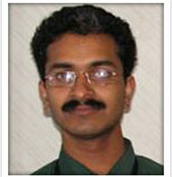
Dr Biju Joseph
Cytogenetic, Mutation Detection, Methylation Status, Fragment Analysis of
RB1 Gene and Phenotype Correlation in Retinoblastoma Patients from India.
2005
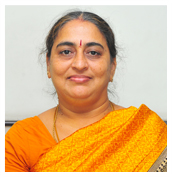
Dr S Sripriya
Genetic Association Studies, Genome Wide Linkage Analysis and Mutation
Screening in Primary Open Angle and Closed Angle Glaucomas. 2006
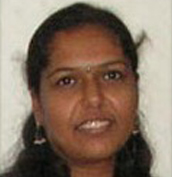
Dr S Uthra
Diabetic Retinopathy: Genetic Association Studies of Candidate Genes in a
South Indian Population-Based Cohort. 2008

Dr J Madhavan
Gene expression quantification of candidate genes and retinal cell specific
markers in humanretinoblastoma and its association with the phenotype of the
disease. 2008
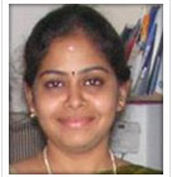
Dr G Mamatha
Molecular Genetics of retinitis pigmentosa and Leber’s congenital amaurosis.
2009
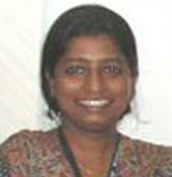
Dr Vinita Kumari
Molecular Genetics of Diabetic retinopathy – genome wide association and
candidate gene studies.
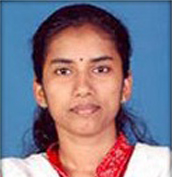
Dr P Ferdina Marie Sharmila
Gene mapping of ocular Quantitative trait loci
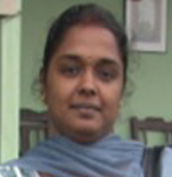
Dr Sathya Priya Chandrasekhar
Homoygosity Mapping based genetic analysis of autosomal ressive families by
Bardet-Biedl syndrome in Indian Population 2016

Dr D Sudha
Clinical, genetic and molecular studies on X-linked retinoschisis 2017
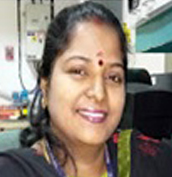
Dr S Srilekha
Genetic analysis of consanguineous south Indian families with Leber
congenital amaurosis and retinitis pigmentosa using homozygosity mapping
2017
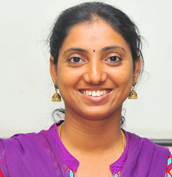
Dr N Srikrupa
Leber Congenital Amaurosis: Clinical profiling and genetic analysis using
high throughput reseqeuncing in an Indian cohort 2018
Research Fellows
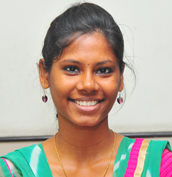
Ms. Suganya K*
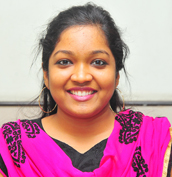
Ms. Rizza A*
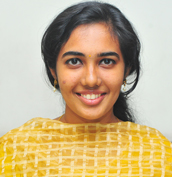
Ms Lakshmi Priyanka*

Ms Harshavardhini*

Ms Ahwathi P Nair*
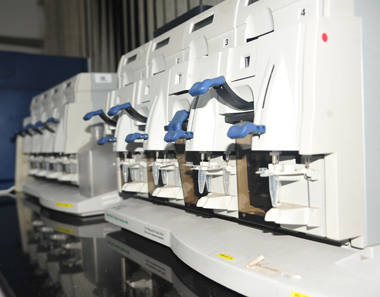
Affymetrix work station
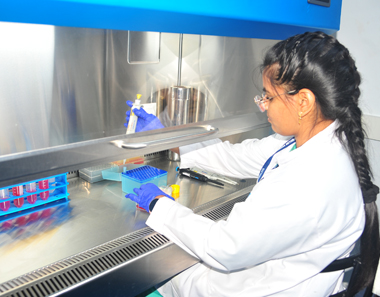
Cell Culture Facility
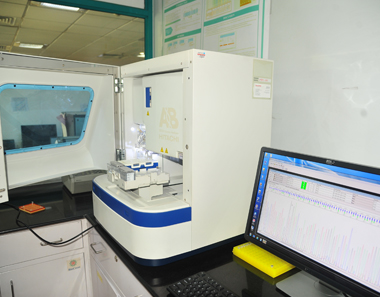
Genotype Analyser
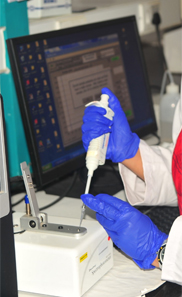
Nano drop Facility
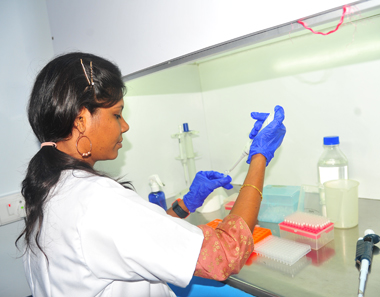
Pre PCR Room Faclity
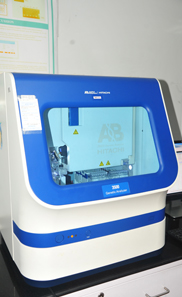
Sanger Sequencer
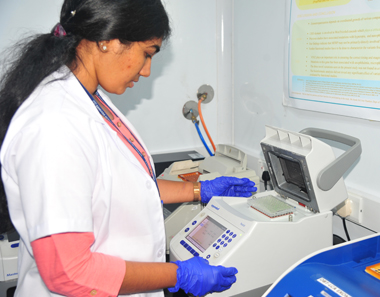
Thermocycler
Sankara Nethralaya ONGC Genetics and Molecular Biology Laboratory
Vision Research Foundation,
18, College Road, Nungambakkam,
Chennai - 600 006.
Phone: 044-42271807, 044-42271500, (Extn: 1308)
Email: genetics@snmail.org
